
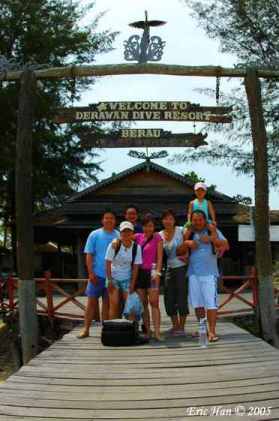
I contacted Gimmy, who linked me up with the trip leader, Eric Han. After a flurry of e-mail exchange, my name was on the list for the trip - all paid up, and air tickets all booked. With the trip now firmly fixed in my diary, I could no longer contain the excitement and anticipation of sucking compressed air again! And back to the Internet for a virtual fix of underwater experience in the Derawan chain of islands. The group would be based in Derawan Dive Resort. With a shot at Google, I was soon at their website. Somehow, I had put myself into a place also famous for her macro life. But on further reading, my excitement level shot up a notch, besides the manta rays at Sangalaki, a jellyfish lake at Kakaban would be waiting. There are only two such lakes in the world, the other one is in Palau. Then I launched Google Earth, and navigated myself to the location, to take a satellite view of the islands. It was of very low resolution, I could only locate the Kakaban and Maratua atolls, Derawan and Sangalaki appeared as light blue spots among the darker blue sea.
D-day, 17 September 2005, soon arrived, and I was at Changi Airport Terminal 2 at 0610 hrs, 20 minutes earlier then the time stipulated by Eric. So I headed to Burger King for breakfast. Other then Gimmy, I had never met any other members of the group, not even Eric. I only knew their names from Eric's e-mail recipient list: Amy, Liana and Desmond. I soon linked up with Gimmy, Eric and Amy, and we checked in at the SilkAir counter at 0700 hrs. We were behind a long queue for the SIA check-in counters when a kind SIA officer rerouted us to a group check-in counter where there was nobody. Thank you, sir.

The SilkAir flight MI847 was scheduled to take-off at 0755 hrs, and I have yet to see the faces of Liana and Desmond when I had crossed the passport control counter and made my way into the plane. I only had a glimpse of them when they finally appeared and made their way to the back of the plane - and they had a little girl trailing them!
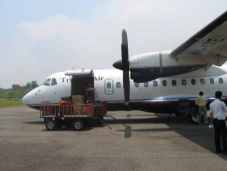 MI847 would take us to Balikpapan in East Kalimantan, then we would take a domestic flight to Berau, or Tanjung Redeb as it is indicated in many maps. The flight from Singapore to Balikpapan took only 2 hours, and we connected to Berau on a KalStar Air propeller driven plane, this took about another hour. The propeller plane even came with two air hostesses - distributing boxed tit-bits: a sealed cup of water and some corn crackers. Berau is located on the upper reaches of Berau River, and we had to take a 2-hour fast boat trip to reach Derawan Island. A group of 4 Japanese were also on the same journey to Derawan Island. On the boat to Derawan, I got to know Mike, who informed me that he would be the dive master for the Singapore group.
MI847 would take us to Balikpapan in East Kalimantan, then we would take a domestic flight to Berau, or Tanjung Redeb as it is indicated in many maps. The flight from Singapore to Balikpapan took only 2 hours, and we connected to Berau on a KalStar Air propeller driven plane, this took about another hour. The propeller plane even came with two air hostesses - distributing boxed tit-bits: a sealed cup of water and some corn crackers. Berau is located on the upper reaches of Berau River, and we had to take a 2-hour fast boat trip to reach Derawan Island. A group of 4 Japanese were also on the same journey to Derawan Island. On the boat to Derawan, I got to know Mike, who informed me that he would be the dive master for the Singapore group.
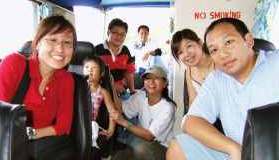 When we reached Derawan Island at 1415 hrs, the boat left us at a "little house" on stilts over water. I couldn't see the "rooms" where we would be putting up, but the Derawan staff on the boat had not off-loaded our luggage, so they must be going on to the "actual resort". Together with the Japanese, we settled down with a cool welcome drink, and a light lunch of mee soto. I soon gathered that the "house on stilts over water" is the dining hall with an attached kitchen. Right in middle of the dining hall was a large well. Looking down into the well, was the sea with lots of fishes swimming around, probably used to "food" thrown down by the resort guests. The resort manager, Eva, gave us the keys to our room. I'd be rooming with Eric, Gimmy with Amy, and Desmond with Liana and their 5-year old daughter, Zara. Check-out dive had been scheduled for 1600 hrs, we had an hour to prepare.
When we reached Derawan Island at 1415 hrs, the boat left us at a "little house" on stilts over water. I couldn't see the "rooms" where we would be putting up, but the Derawan staff on the boat had not off-loaded our luggage, so they must be going on to the "actual resort". Together with the Japanese, we settled down with a cool welcome drink, and a light lunch of mee soto. I soon gathered that the "house on stilts over water" is the dining hall with an attached kitchen. Right in middle of the dining hall was a large well. Looking down into the well, was the sea with lots of fishes swimming around, probably used to "food" thrown down by the resort guests. The resort manager, Eva, gave us the keys to our room. I'd be rooming with Eric, Gimmy with Amy, and Desmond with Liana and their 5-year old daughter, Zara. Check-out dive had been scheduled for 1600 hrs, we had an hour to prepare.
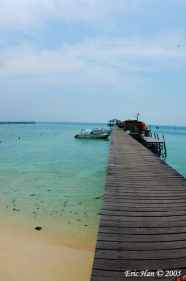 With our stomachs no longer hollow, we made our way outside the dining hall, and across a 200-metre wooden jetty in the bright hot sun. The dive centre was located right on the edge of the island, beside the jetty. And not too far away, were a row of chalets; two rooms to each one, sharing a common verandah. The rooms were furnished with a cupboard, telephone, two single beds, an attached bathroom with toilet and hot water. And the toilet bowl is equipped with a Japanese-style washing spout designed to spray a jet of water between the cheeks of a well placed bum. There were also 2 new plastic bottles of water on the telephone stand; we found out later that we have to refill them either at the dive centre or at the dining hall. Desmond's family got a room with 3 beds. And there was air conditioning, too, but the one in my room never did cool down the air satisfactorily. We found 3 power points - 2 in the room, 1 in the bathroom; these were important for charging batteries for Eric, who, I soon learnt, is a devoted underwater macro photographer. We unpacked our stuff, and brought our dive gear to the dive centre.
With our stomachs no longer hollow, we made our way outside the dining hall, and across a 200-metre wooden jetty in the bright hot sun. The dive centre was located right on the edge of the island, beside the jetty. And not too far away, were a row of chalets; two rooms to each one, sharing a common verandah. The rooms were furnished with a cupboard, telephone, two single beds, an attached bathroom with toilet and hot water. And the toilet bowl is equipped with a Japanese-style washing spout designed to spray a jet of water between the cheeks of a well placed bum. There were also 2 new plastic bottles of water on the telephone stand; we found out later that we have to refill them either at the dive centre or at the dining hall. Desmond's family got a room with 3 beds. And there was air conditioning, too, but the one in my room never did cool down the air satisfactorily. We found 3 power points - 2 in the room, 1 in the bathroom; these were important for charging batteries for Eric, who, I soon learnt, is a devoted underwater macro photographer. We unpacked our stuff, and brought our dive gear to the dive centre.
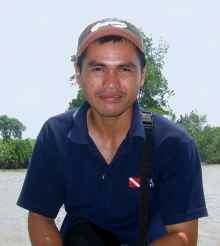 At the dive centre, Mike explained to us the set up of the dive centre and distributed our weights to us. Each of us was assigned a guest number and a large "pigeon hole" for our dry stuff; and my BC was tagged with my number: 7. There were the usual airing room to dry our dive gear and wetsuits, dip tanks for after dive washing of equipment, freshwater soak tanks for cameras and showers for divers. At 1640 hrs, all the new guests went for the check-out dive, led by Dharma (the most senior dive master at the dive centre), to Turtle Bay, just 5 minutes away from the jetty.
At the dive centre, Mike explained to us the set up of the dive centre and distributed our weights to us. Each of us was assigned a guest number and a large "pigeon hole" for our dry stuff; and my BC was tagged with my number: 7. There were the usual airing room to dry our dive gear and wetsuits, dip tanks for after dive washing of equipment, freshwater soak tanks for cameras and showers for divers. At 1640 hrs, all the new guests went for the check-out dive, led by Dharma (the most senior dive master at the dive centre), to Turtle Bay, just 5 minutes away from the jetty.
Zara was left behind on the beach by the dive centre, to get acquainted with a 4-year old little girl, Marin Takashi, who arrived with her parents just the day before. Fortunately for Zara, Marin spoke very good English. When we returned from the check-out dive, the 2 little girls were playing happily with the local kids, children of the resort staff, on the beach.
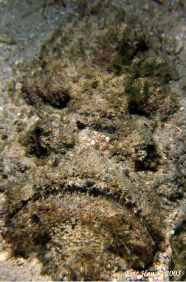 During the check-out dive, the whole group of went down underwater with no pre-assigned buddy pairs, and yet the dive master had emphasized that buddies should stay together. Desmond and Liana are a natural pair, while Gimmy and Eric had dived together on many occasions and are both macro enthusiasts; I eventually got together with Amy underwater, disturbing a 1.5-metre turtle at rest midway through the dive. But for the rest of the trip, there were no rigid buddy pairs, we sort of dived together as an amorphous group. The check-out dive was not exceedingly exciting, but it was my first breath of compress air for the year, and apparently Eric had come across a stargazer, which would become an obsession for the whole sojourn at Derawan. As for me, I found out that I am not as fit as I was, and it was affecting my breathing rate and air consumption; I also found out that Amy's air requirement was much less then mine.
During the check-out dive, the whole group of went down underwater with no pre-assigned buddy pairs, and yet the dive master had emphasized that buddies should stay together. Desmond and Liana are a natural pair, while Gimmy and Eric had dived together on many occasions and are both macro enthusiasts; I eventually got together with Amy underwater, disturbing a 1.5-metre turtle at rest midway through the dive. But for the rest of the trip, there were no rigid buddy pairs, we sort of dived together as an amorphous group. The check-out dive was not exceedingly exciting, but it was my first breath of compress air for the year, and apparently Eric had come across a stargazer, which would become an obsession for the whole sojourn at Derawan. As for me, I found out that I am not as fit as I was, and it was affecting my breathing rate and air consumption; I also found out that Amy's air requirement was much less then mine.
Meal schedule at the resort is: 0700 hrs - 0900 hrs breakfast, 1200 hrs - 1400 hrs lunch, and 1900 hrs - 2100 hrs dinner. So at 1900 hrs, all of us marched in small groups down the 200-metre wooden jetty for our first proper meal at the resort. The dining hall served Asian fare in a buffet style. Throughout the week, dinner would comprise various combinations of cold salad, soup, rice, stir fried vermicelli, sauteed fish, stir fried vegetable, various types of fritters, tofu, and beef or chicken every other day, rounded off by desert comprising local fresh fruits and pastry. Coffee and tea were also available. Fizzy drinks and alcohol (beer and wine) are charged to the room. Breakfast would be toast with butter and all sorts of jams, porridge with fried Asian fried pretzels (unexpanded version of yau char kuai), fried rice or fried mee, banana fritters, and a constant flow of fresh fruit juices (banana, apple, orange, watermelon or pineapple). Except for the last day, we had our lunches in between dives beyond Derawan island. The lunches were packed in large round plastic containers with separate compartments for the various accompaniments to rice, together with fruits and cakes. The dive boat would also carry a container of hot tea with a box of sugar!
During the week, breakfast and dinner were invariably consumed as 3 different groups: ours, the Japanese (the Takashi family together with the 4 that arrived together with us, and 2 British couples who had arrived a couple of days before. For breakfast, after the first morning, our group moved out to a table outside the dining hall; to enjoy the morning sea breeze. During our breakfasts, we would invariably observed the return of 2, sometimes 3, young Japanese women, who would make their way to the jetty with their cameras for their underwater morning macro orgy. Dinner was consumed indoors, because there was not enough light outside, and dinners would usually involve some of us filling out our dive logs.
The jetty is a dive site of some pride to the resort. At high tide, the bottom is 4 metres deep, and gradually slopes out south, down to 15 metres or more. While the bottom is filled with rubbles, the gradual sand slope is dotted with large healthy coral outcrops. And it is a heaven of macro life and healthy marine life; during a night dive there I even found a large multi-frond red sea fan growing on a stake supporting the platform at the jetty end, with red squat lobsters living on it!
For the first night, the girls, who roomed next to Eric and I in the same chalet, complained of a warm and sleepless night - their air-conditioning did not seem to work at all! Eric thought that the night felt warm despite the air-conditioning. As for me, I thought I slept well, but I woke up with a bad headache. The girls eventually discovered that they did not set the temperature and the fan speed of their air-condition unit. As for Eric, he realized that the electricity was cut-off momentarily during the night, and when it came back, the air-condition unit stayed at the "stand-by" mode.
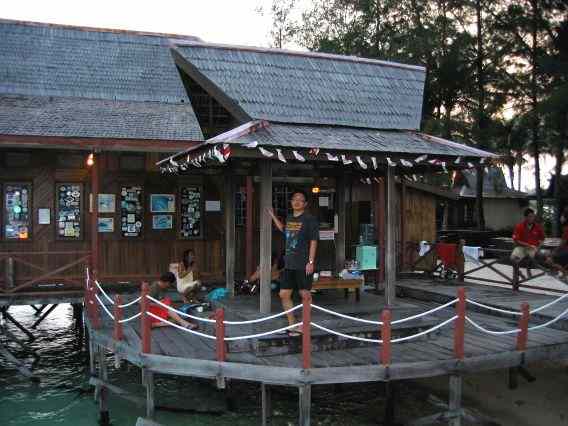 I had woken up early Sunday morning and wandered to the dive centre. A notice indicated that the centre is opened at 0600 hrs to cater for dawn divers, and only closed at 2000 hrs. But I found out that the staff actually became active earlier than the posted hour and closed only when the last diver had finished the day. On the eastern front wall between the window openings were maps of the 4 main islands in the group - Derawan, Sangalaki, Kakaban and Maratua - with all the dive sites clearly marked out. And on the left of all these was an impressive 3-D model of the mini-archipelago, showing the underwater ground features down to over 20 metres. On the north and west walls were white boards showing the dive itineraries of the different dive groups. I found the one for my group, with all our names on it, and the itinerary: Dive 1, 0830 hrs, Coral Canyon, Derawan; dive 2, 1100 hrs, Sangalaki, and finally, dive 3, 1400 hrs, Sangalaki. Great - I'd be seeing mantas! Our boat for the week was called Barracuda. Assisting Mike would be Freddy, the pilot, and youthful Osman, the boat boy. Freddy used to be dynamite fisherman, but the resort persuaded him to give that up and employed him as a pilot.
I had woken up early Sunday morning and wandered to the dive centre. A notice indicated that the centre is opened at 0600 hrs to cater for dawn divers, and only closed at 2000 hrs. But I found out that the staff actually became active earlier than the posted hour and closed only when the last diver had finished the day. On the eastern front wall between the window openings were maps of the 4 main islands in the group - Derawan, Sangalaki, Kakaban and Maratua - with all the dive sites clearly marked out. And on the left of all these was an impressive 3-D model of the mini-archipelago, showing the underwater ground features down to over 20 metres. On the north and west walls were white boards showing the dive itineraries of the different dive groups. I found the one for my group, with all our names on it, and the itinerary: Dive 1, 0830 hrs, Coral Canyon, Derawan; dive 2, 1100 hrs, Sangalaki, and finally, dive 3, 1400 hrs, Sangalaki. Great - I'd be seeing mantas! Our boat for the week was called Barracuda. Assisting Mike would be Freddy, the pilot, and youthful Osman, the boat boy. Freddy used to be dynamite fisherman, but the resort persuaded him to give that up and employed him as a pilot.
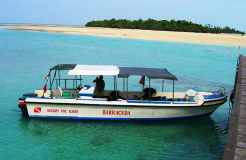 With full enthusiasm, I got all my things ready at the dive centre at 0820 hrs. It wasn't difficult, the dive centre was only half-minute away from my room! The rest weren't there yet; Eric and Gimmy were preparing their cameras, Liana had to explain to Zara that daddy and mummy would be away only for an hour or so, just like the day before, and Amy was waiting for the others. Well, it was supposed to be a holiday for everybody, there was no point for me to be uptight over a few minutes. This gave me time to get more acquainted with Mike.
With full enthusiasm, I got all my things ready at the dive centre at 0820 hrs. It wasn't difficult, the dive centre was only half-minute away from my room! The rest weren't there yet; Eric and Gimmy were preparing their cameras, Liana had to explain to Zara that daddy and mummy would be away only for an hour or so, just like the day before, and Amy was waiting for the others. Well, it was supposed to be a holiday for everybody, there was no point for me to be uptight over a few minutes. This gave me time to get more acquainted with Mike.
When all 6 of us assembled at the dive centre at 0830 hrs, Mike produced a papier mache 3-D model of the dive site and briefed us on it. I was impressed. When we climbed into the boat, it was 0840 hrs. Near the stern was a container with a big plastic bottle of water for each of us, with our names scrawled in ink; these were invariably refilled every time the boat docked at the dive centre. The dive site was just a few minutes away, to the south-east. My Suunto α indicated that I hit water at 0852 hrs - as good a time as any. We did not go beyond 24 metres for this dive. I guessed this was a dive for Mike to assess each of us underwater. It was also time for us to assess this English spouting marine Dayak. He carried with him a magnetic slate, on which he would write the names of various creatures he would point to us - well, Amy mostly, since she was the most enthusiastic about learning everything she could from any of us. For Gimmy and Eric, they had encountered most of them before. For me, it was the first time I saw with my own eyes after reading about them for years, pygmy seahorses. I was impressed by the effort the local dive masters must have put in to be able to spell out all these complicated names. And they could even spout out the Latin names of many of them. Eventually we found out that Mike used to be an electrician, and he had only been a dive master for three years. Harry, a fellow dive master, divulge that Mike could give dive briefings in Italian.
On returning to the dive centre after the dive, it was 1000 hrs. And Zara was at the dive centre, a relieved face on seeing her parents. Mike informed us that the boat would leave for Sangalaki at 1100 hrs, and that we would be having our lunch on board, after the first dive at Sangalaki. For the mantas, everybody was on time, including Zara, who was coming along with her parents. Liana would not dive and stay on the boat with Zara. Going to Sangalaki was supposed to take 45 minutes, but Freddy brought us there in 30. The Japanese group turned up at Sangalaki later, with Marin on board. And Zara and Marin got to play together.
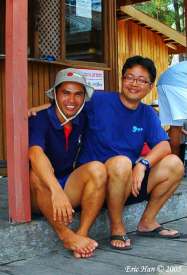
 There are 2 main sites for manta sighting at Sangalaki: Manta Parade and Manta Cleaning Station. For this trip, we would eventually do 3 dives at each site; except for the first one, the rest would be disappointingly fruitless. Manta Parade is essentially fairly straight and clear sandy boulevard 16 metre deep, lined on either side by a gradual slope dotted with large coral heads which eventually spread out into a healthy carpet of coral reef at depth of 10 metres. Divers had commonly reported sighting more than a dozen manta rays sweeping down the sandy lane. Normally, divers are supposed to line themselves up on one side of the boulevard, and wait for the stars to appear, but Mike failed to tell us about it for this dive, and as an amorphous group, we sort of wandered around the place, kicking up the sand, sending the grass eels flashing back into the holes. About 25 minutes into the dive, I was drifting slowly with the current in a north-westerly direction when I saw Mike signaling at me to follow him, he had written "manta" on his slate! After a hard 20-metre fin against the current, up a coral slope, I finally laid eyes on part of the great underbelly of the giant. It was hovering behind the a large coral hill. I kept my body close to the coral slope, finning slowly up, trying to peer over the hill - just like my former days of doing recon in the army. Eric later described me as a mountain bandit, peering at potential victims. The lone giant hovered for a while at its position and then made an elegant u-turn and swept a few metres above me and glided away. As I looked at it gliding into the blue, I saw Eric at the foot of the coral hill, his camera following the manta's trajectory, snapping away. Then all of us waited at the spot, hoping that it would return for an encore performance, but it was not to be. It would be the only manta we saw on this trip - and Liana missed out on it.
There are 2 main sites for manta sighting at Sangalaki: Manta Parade and Manta Cleaning Station. For this trip, we would eventually do 3 dives at each site; except for the first one, the rest would be disappointingly fruitless. Manta Parade is essentially fairly straight and clear sandy boulevard 16 metre deep, lined on either side by a gradual slope dotted with large coral heads which eventually spread out into a healthy carpet of coral reef at depth of 10 metres. Divers had commonly reported sighting more than a dozen manta rays sweeping down the sandy lane. Normally, divers are supposed to line themselves up on one side of the boulevard, and wait for the stars to appear, but Mike failed to tell us about it for this dive, and as an amorphous group, we sort of wandered around the place, kicking up the sand, sending the grass eels flashing back into the holes. About 25 minutes into the dive, I was drifting slowly with the current in a north-westerly direction when I saw Mike signaling at me to follow him, he had written "manta" on his slate! After a hard 20-metre fin against the current, up a coral slope, I finally laid eyes on part of the great underbelly of the giant. It was hovering behind the a large coral hill. I kept my body close to the coral slope, finning slowly up, trying to peer over the hill - just like my former days of doing recon in the army. Eric later described me as a mountain bandit, peering at potential victims. The lone giant hovered for a while at its position and then made an elegant u-turn and swept a few metres above me and glided away. As I looked at it gliding into the blue, I saw Eric at the foot of the coral hill, his camera following the manta's trajectory, snapping away. Then all of us waited at the spot, hoping that it would return for an encore performance, but it was not to be. It would be the only manta we saw on this trip - and Liana missed out on it.
After the excitement of the lone manta, we returned to the boat for lunch. When I got onto the boat, I was feeling very tired, probably due to a combination of excitement, over-exertion, and poor fitness; I became nauseated. While everybody else was digging into lunch, I was trying to calm myself down and willing my stomach to be still. To no avail, within minutes, I was bend double over the gunwale, heaving my stomach out. I hadn't eaten much during breakfast, so I was retching out mostly liquid in 4 great heaves, that surely sounded nauseated to the others. And Zara was slightly distressed, asking her mother what was happening. After that, I only took some hot unsweetened tea and a banana.
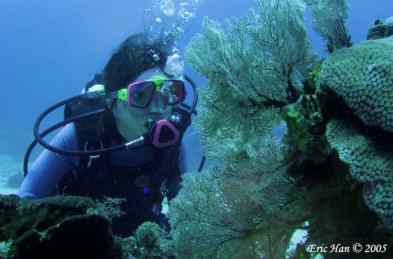 I decided to miss out the second dive of the day to the Manta Cleaning Station. Liana had decided to go underwater, as Freddy together with Osman were ready to look out for Zara. After the group went under, Zara was transferred to Marin's boat to play with her. I slept on board the boat until the group surfaced with disappointed miens - no manta.
I decided to miss out the second dive of the day to the Manta Cleaning Station. Liana had decided to go underwater, as Freddy together with Osman were ready to look out for Zara. After the group went under, Zara was transferred to Marin's boat to play with her. I slept on board the boat until the group surfaced with disappointed miens - no manta.
That same evening, after we returned to Derawan, Eric, Gimmy and Amy went jetty diving at dusk, 1800 hrs. And Eric had wanted to search out his stargazer. On the way back from Sangalaki, the boat had stopped for a while to off-load the night divers' equipment on the platform at the jetty end. About a dozen fully charged tanks were always available there. After an hour's rest or so, with Gimmy and Eric replacing the batteries in their camera strobes, the night dive party trudged out to the jetty end for their dive. Mike, who was not obliged to accompany the group joined in, and for that matter for all the night dives that we did. Apparently, the dive went very well. As for me, I waited for them on shore, so that we could have dinner together; however, I was unable to eat much during dinner. My inability to eat much continued for the next 3 days; I had to force myself to swallow, experiencing some pain, especially during lunch in between dives. I did not understand what was happening though, but it did came to my mind that I had not really prepared myself, fitness wise, for this trip, where on almost every dive, we encountered current.
   |
GO TO PART 2 |    |